2018 MERCEDES-BENZ CLA ESP
[x] Cancel search: ESPPage 264 of 326
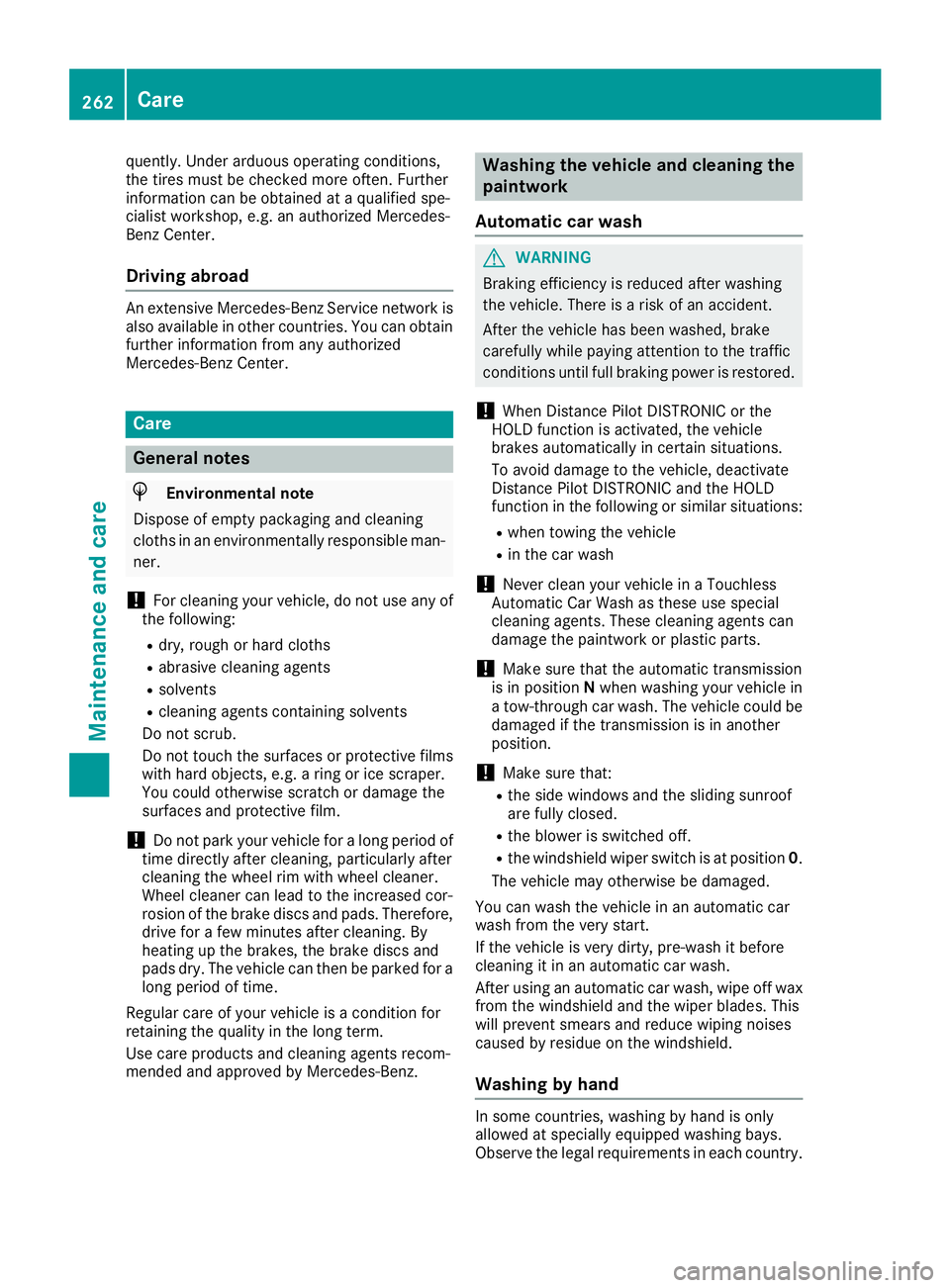
quently. Under arduous operatin gc onditions,
the tires must be checked more often. Further
information can be obtained at aq ualified spe-
cialist workshop, e.g. an authorized Mercedes-
Ben zC enter.
Driving abroad An extensive Mercedes-Benz Service network is
also available in other countries. You can obtain
further information from any authorized
Mercedes-Benz Center.
Care
General notes
H Environmental note
Dispose of empty packagin ga nd cleaning
cloths in an environmentally responsible man-
ner.
! For cleanin gy our vehicle, do not use any of
the following: R
dry, rough or hard cloths R
abrasive cleanin ga gentsR
solvents R
cleanin ga gent sc ontainin gs olvents
Do not scrub.
Do not touch the surfaces or protective films
with hard objects, e.g. ar ing or ice scraper.
You could otherwise scratch or damage the
surfaces and protective film.
! Do not park your vehicle for al ong period of
time directly after cleaning, particularly after
cleanin gt he wheel rim with wheel cleaner.
Wheel cleaner can lead to the increased cor-
rosion of the brake discs and pads. Therefore,
drive for af ew minutes after cleaning. By
heating up the brakes, the brake discs and
pads dry. The vehicle can then be parked for a
long period of time.
Regular care of your vehicle is ac ondition for
retaining the quality in the long term.
Use care product sa nd cleanin ga gent sr ecom-
mended and approved by Mercedes-Benz. Washing the vehicle and cleaning the
paintwork
Automatic car wash
G WARNING
Braking efficiency is reduced after washing
the vehicle. There is ar isk of an accident.
After the vehicle has been washed, brake
carefully while paying attention to the traffic
condition su ntil full brakin gp ower is restored.
! When Distance Pilot DISTRONIC or the
HOLD function is activated, the vehicle
brakes automatically in certain situations.
To avoid damage to the vehicle, deactivate
Distance Pilot DISTRONIC and the HOLD
function in the following or similar situations: R
when towing the vehicle R
in the car wash
! Never clean your vehicle in aT ouchless
Automatic Car Wash as these use special
cleanin ga gents. These cleanin ga gent sc an
damage the paintwor korp lastic parts.
! Make sure that the automatic transmission
is in position N when washing your vehicle in
at ow-through car wash. The vehicle could be
damaged if the transmission is in another
position.
! Make sure that: R
the side windows and the sliding sunroof
are fully closed. R
the blower is switched off. R
the windshield wiper switch is at position 0 .
The vehicle may otherwise be damaged.
You can wash the vehicle in an automatic car
wash from the very start.
If the vehicle is very dirty, pre-wash it before
cleanin gitinana utomatic car wash.
After using an automatic car wash, wipe off wax
from the windshield and the wiper blades. This
will preven ts mears and reduce wiping noises
caused by residue on the windshield.
Washing by hand
In some countries, washing by hand is only
allowed at specially equipped washing bays.
Observe the legal requirements in each country.262
Care
Maintenance and care
Page 274 of 326
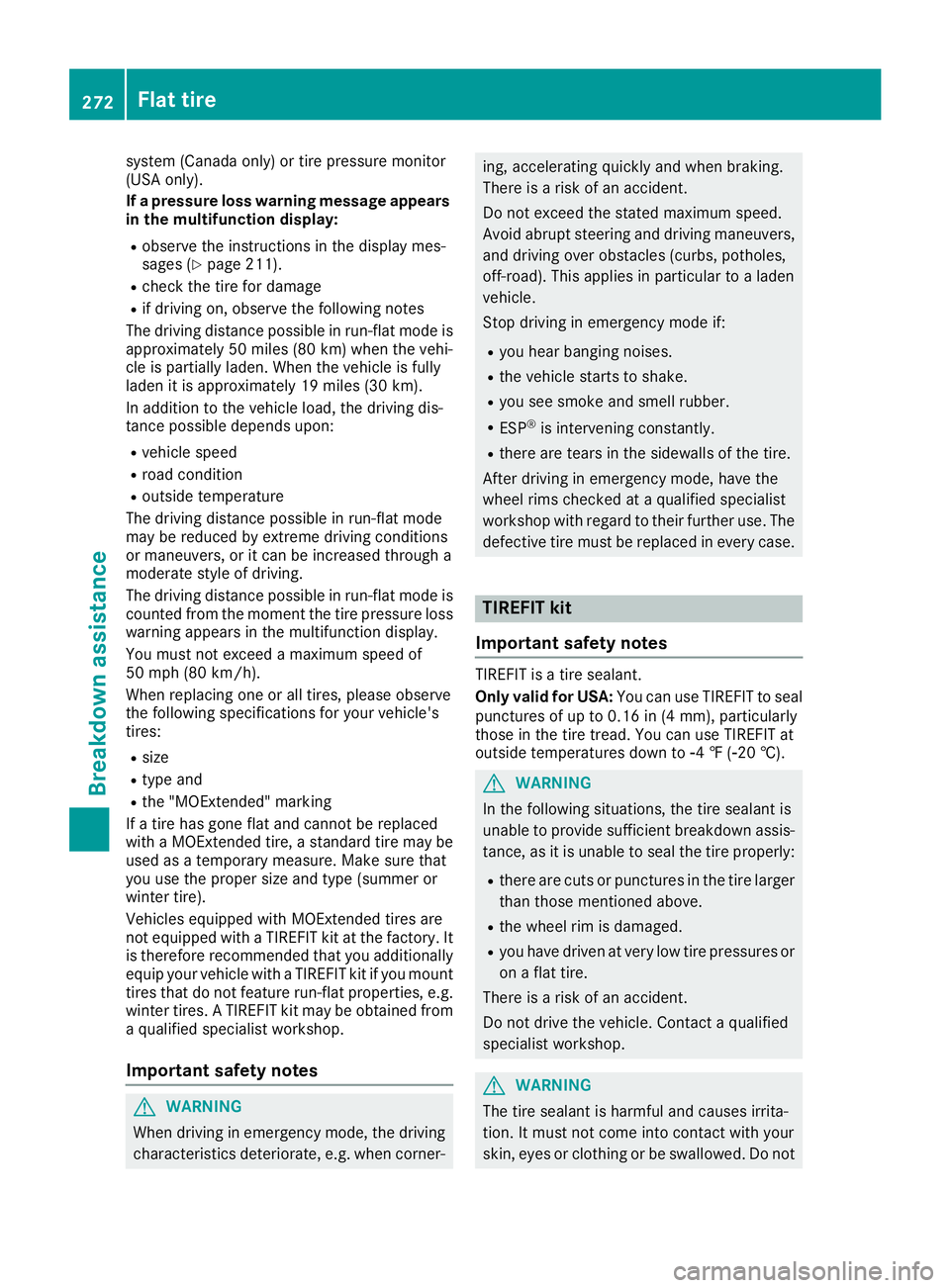
system (Canad ao nly) or tire pressure monitor
(USA only).
If ap ressure loss warning message appears
in the multifunction display: R
observe the instructions in the displa ym es-
sages ( Y
page 211).R
check the tire for damage R
if driving on, observe the following notes
The driving distance possible in run-flat mode is
approximately 50 miles (80 km) when the vehi-
cle is partiall yl aden. When the vehicle is fully
laden it is approximately 19 miles (30 km).
In addition to the vehicle load, the driving dis-
tance possible depends upon: R
vehicle speed R
road condition R
outside temperature
The driving distance possible in run-flat mode
may be reduced by extreme driving conditions
or maneuvers, or it can be increased through a
moderate style of driving.
The driving distance possible in run-flat mode is
counted from the moment the tire pressure loss
warning appears in the multifunction display.
You must not exceed am aximum speed of
50 mph (80 km/h).
When replacing one or all tires, please observe
the following specifications for your vehicle's
tires: R
size R
type and R
the "MOExtended" marking
If at ire has gone flat and cannot be replaced
with aM OExtended tire, as tandard tire may be
used as at emporary measure. Make sure that
you use the proper size and type (summer or
winter tire).
Vehicles equipped with MOExtended tires are
not equipped with aT IREFIT kit at the factory. It
is therefore recommended that you additionally
equip your vehicle with aT IREFIT kit if you mount
tires that do not feature run-flat properties, e.g.
winter tires. AT IREFIT kit may be obtained from
aq ualified specialist workshop.
Important safety notes
G WARNING
When driving in emergency mode, the driving
characteristics deteriorate, e.g. when corner- ing, accelerating quickly and when braking.
There is ar isk of an accident.
Do not exceed the stated maximum speed.
Avoid abrupt steering and driving maneuvers,
and driving over obstacles (curbs, potholes,
off-road). This applies in particular to al aden
vehicle.
Stop driving in emergency mode if: R
you hear banging noises. R
the vehicle starts to shake. R
you see smoke and smell rubber. R
ESP ®
is intervenin gc onstantly.R
there are tears in the sidewalls of the tire.
After driving in emergency mode, have the
wheel rims checked at aq ualified specialist
workshop with regard to their further use. The
defective tire must be replaced in every case.
TIREFIT kit
Important safety notes TIREFIT is at ire sealant.
Only valid for USA: You can use TIREFIT to seal
punctures of up to 0.16 in (4 mm), particularly
those in the tire tread. You can use TIREFIT at
outside temperatures down to �
Page 278 of 326
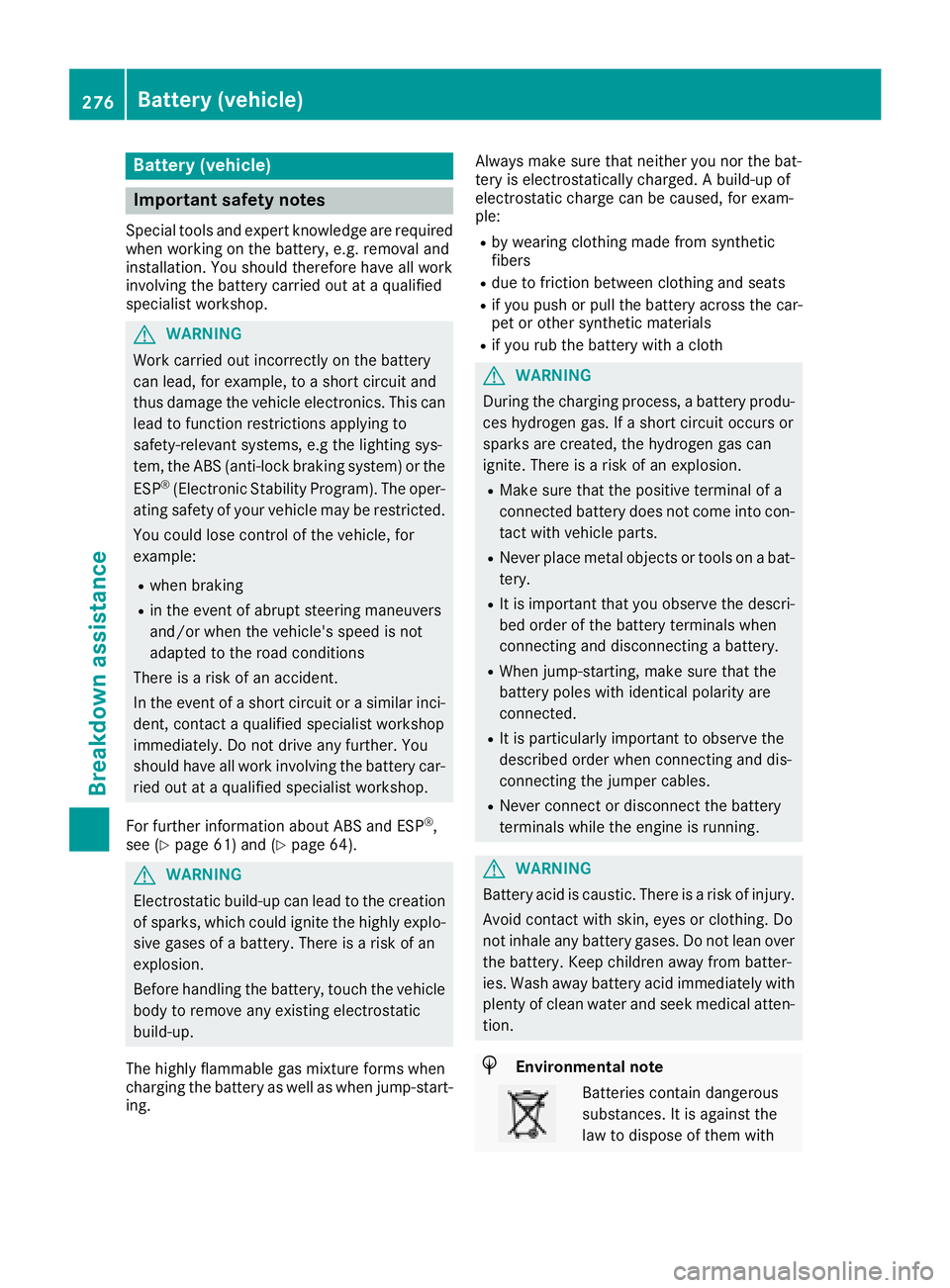
Battery (vehicle)
Important safety notes Specia lt ool sa nd expert knowledg ea re required
when working on the battery ,e .g .r emova la nd
installation. Yo us houl dt herefore have al lw or k
involving the battery carrie do ut at aq uali fied
specialist workshop.
G WARNING
Wor kc arrie do ut incorrectly on the battery
can lead ,f or example, to as hort circui ta nd
thu sd amag et he vehicl ee le ctronics .T hi sc an
lead to functio nr estrictions applying to
safety-relevant systems, e.g the lighting sys-
tem, the ABS (anti-lock braking system )ort he
ESP ®
(Electronic Stability Program). The oper-
ating safety of your vehicl em ay be restricted.
Yo uc ould lose contro loft he vehicle, for
example: R
when braking R
in the event of abrupt steering maneuvers
and/or when the vehicle's speed is not
adapted to the roa dc onditions
There is ar is kofana ccident.
In the event of as hort circui tora similar inci-
dent, contact aq uali fied specialist workshop
immediately. Do not drive any further .Y ou
shoul dh av ea ll work involving the battery car-
rie do ut at aq uali fied specialist workshop.
For further informatio na bout ABS and ESP ®
,
see ( Y
page 61 )a nd ( Y
page 64).
G WARNING
Electrostati cb uild -u pc an lead to the creation
of sparks, which could ignite the highl ye xplo-
sive gases of ab at tery .T here is ar is kofa n
explosion.
Before handling the battery ,t ouch the vehicle
body to remove any existing electrostatic
build-up.
The highl yf lammabl eg as mixture form sw he n
charging the battery as well as when jump-start-
ing. Alway sm ak es ur et ha tn either yo un or the bat-
tery is electrostaticall yc harged. Ab uild -u po f
electrostatic charge can be caused ,f or exam-
ple: R
by wearing clothing made from synthetic
fibers R
du etof rictio nb et ween clothing and seatsR
if yo up us horp ul lt he battery across the car-
pe toro the rs yn theti cm at erialsR
if yo ur ub the battery with ac loth
G WARNING
During the charging process ,ab at tery produ-
ces hydrogen gas. If as hort circui to ccurs or
sparks are created ,t he hydrogen ga sc an
ignite .T here is ar is kofane xplosion.R
Make sure tha tt he positive terminal of a
connected battery does not come into con-
tact with vehicl ep ar ts.R
Never place meta lo bj ects or tool sonab at -
tery. R
It is important tha ty ou observe the descri-
be do rder of the battery terminal sw he n
connecting and disconnecting ab at tery.R
Whe nj ump-starting ,m ak es ur et ha tt he
battery pole sw it hi de ntical polarity are
connected. R
It is particularly important to observe the
describe do rder when connecting and dis-
connecting the jumper cables. R
Never connect or disconnect the battery
terminal sw hile the engine is running.
G WARNING
Battery aci disc austic .T here is ar is kofi njury.
Avoi dc ontact with skin, eyes or clothing. Do
not inhal ea ny battery gases .Don ot lean over
the battery .K ee pc hildren away from batter-
ies. Wash away battery aci di mmediatel yw it h
plenty of clean water and see km edica la tten-
tion.
H Environmental note
Batterie sc ontain dangerous
substances. It is against the
la wtod is pose of them with276
Battery (vehicle)
Breakdo wn assis tance
Page 279 of 326
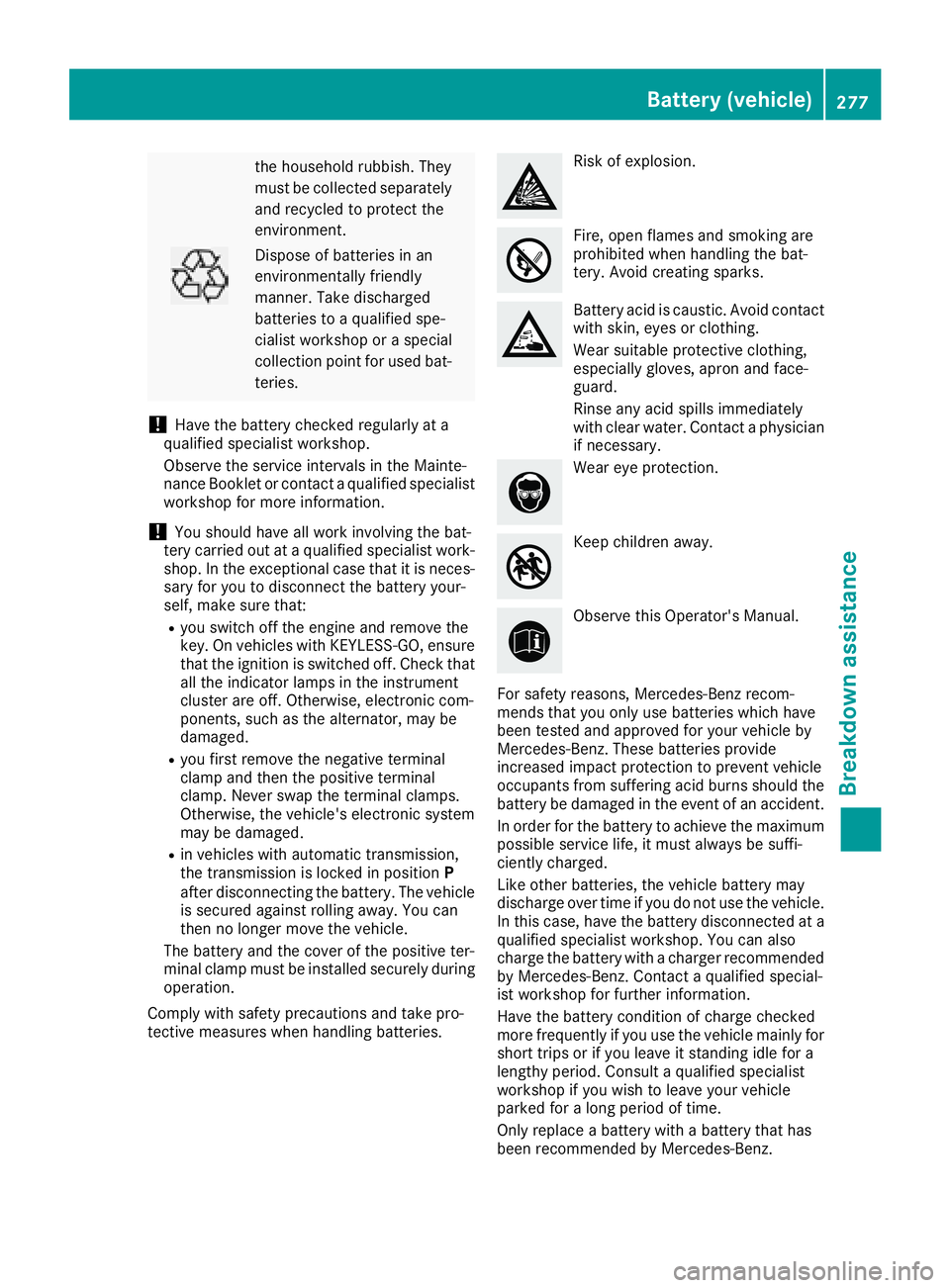
the househol dr ubbish .T hey
must be collected separately
and recycle dtop rotect the
environment.
Dispose of batteries in an
environmentall yf riendly
manner. Take discharged
batteries to aq uali fied spe-
cialist workshop or as pe cial
collectio np oi nt for used bat-
teries.
! Hav et he battery checked regularly at a
qualified specialis tw or kshop.
Observe the service intervals in the Mainte-
nanc eB ookle torc ontact aq uali fied specialist
workshop for mor ei nformation.
! Yo us houl dh av ea ll work involvin gt he bat-
tery carrie do ut at aq uali fied specialis tw or k-
shop. In the exceptiona lc as et ha titi sn eces-
sary for yo utod is connect the battery your-
self, make sure that: R
yo us wi tch off the engine and remove the
key .Onv ehicles with KEYLESS-GO, ensure
tha tt he ignition is switched off .C he ck that
al lt he indicator lamps in the instrument
cluste ra re off .O therwise, electronic com-
ponents ,s uc hast he alternator, ma yb e
damaged. R
yo uf irst remove the negative terminal
clamp and the nt he positive terminal
clamp. Never swap the termina lc lamps.
Otherwise, the vehicle' se le ctronic system
ma ybed amaged .R
in vehicles with automatic transmission,
the transmission is locked in position P
after disconnecting the battery .T he vehicle
is secur ed a gainst rolling away .Y ou ca
n
the nnol on ge rm ov et he vehicle.
The battery and the cove roft he positive ter-
minal clamp must be installe ds ec urel yd ur ing
operation.
Compl yw it hs af ety precautions and take pro-
tective measures when handling batteries. Risk of explosion.
Fire, open flames and smoking are
prohibited when handling the bat-
tery .A voi dc reating sparks.
Battery aci disc austic. Avoi dc ontact
with skin, eyes or clothing.
Wear suitabl ep rotective clothing,
especiall yg lo ves, apron and face-
guard.
Rinse any aci ds pills immediately
with clear water. Contact ap hysician
if necessary.
Wear ey ep rotection.
Kee pc hildren away.
Observe thi sO pe rator' sM an ual.
For safety reasons, Mercedes-Benz recom-
mend st ha ty ou onl yu se batteries which have
been tested and approved for your vehicl eb y
Mercedes-Benz. Thes eb at teries provide
increase di mpact protection to prevent vehicle
occupants fro ms uf ferin ga ci db ur ns shoul dt he
battery be damage dint he event of an accident.
In order for the battery to achieve the maximum
possibl es er vice life, it must always be suffi-
ciently charged.
Like othe rb at teries ,t he vehicl eb at tery may
discharge ove rt im eify ou do not us et he vehicle.
In thi sc ase, have the battery disconnecte data
qualified specialis tw or kshop .Y ou can also
charge the battery with ac harge rr ecommended
by Mercedes-Benz. Contact aq uali fied special-
is tw or kshop for furthe ri nformation.
Hav et he battery condition of charge checked
mor ef requentl yify ou us et he vehicl em ai nl yf or
short trip sorify ou leav eits tanding idle for a
length yp er iod. Consult aq uali fied specialist
workshop if yo uw is htol eave your vehicle
parked for al on gp er io doft ime.
Onl yr eplace ab at tery with ab at tery tha th as
been recommended by Mercedes-Benz.Battery (vehicle) 277
Breakdow na ssistance Z
Page 284 of 326
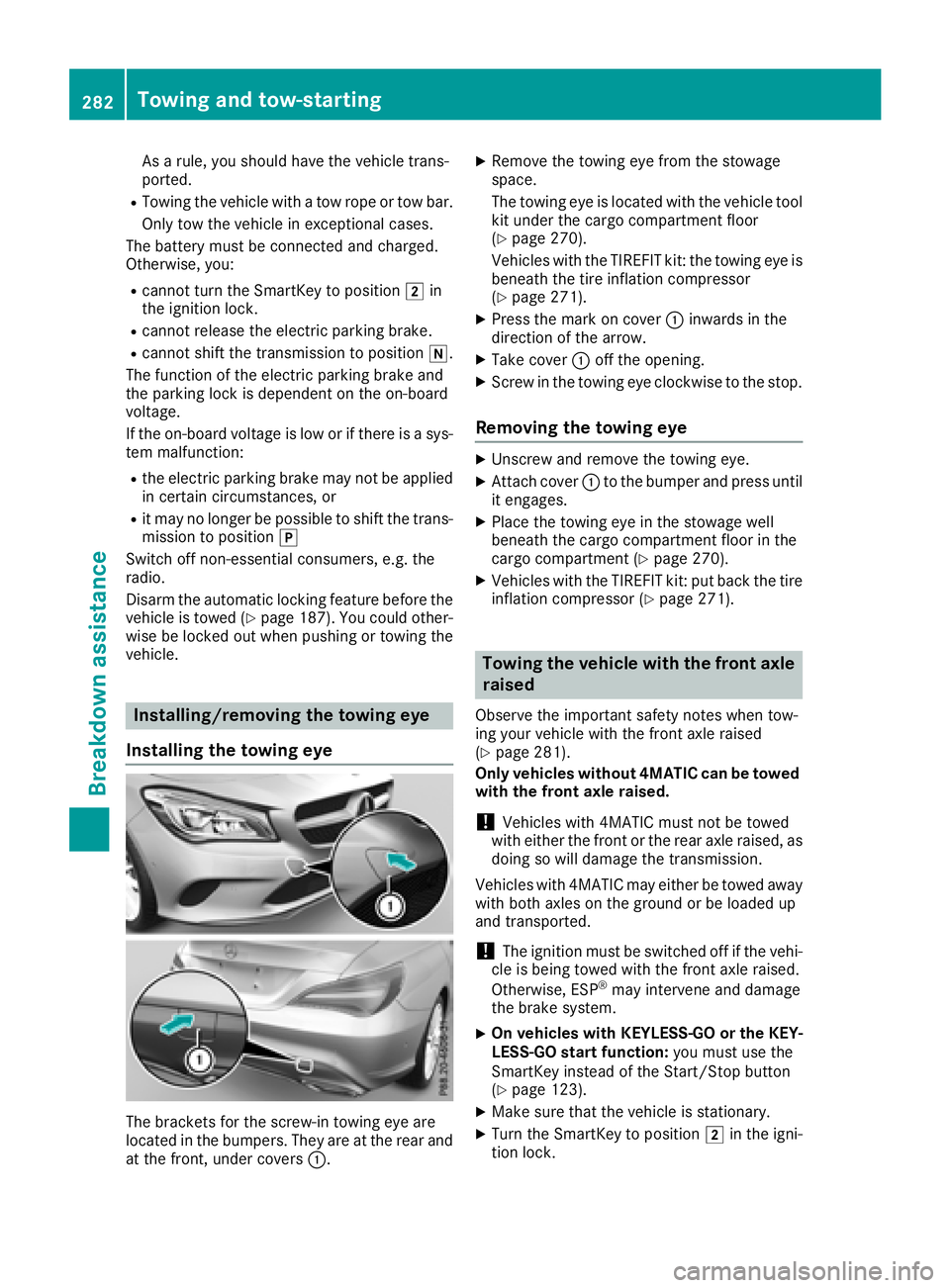
As ar ule, yo us houl dh av et he vehicl et rans-
ported. R
Towing the vehicl ew it hat ow rop eort ow bar.
Onl yt ow the vehicl eine xceptiona lc ases.
The battery must be connected and charged.
Otherwise, you: R
canno tt urn the SmartKe ytop osition �H in
the ignition lock. R
canno tr elease the electri cp ar king brake.R
canno ts hift the transmission to position �\\ .
The functio noft he electri cp ar king brake and
the parking lock is dependent on the on-board
voltage.
If the on-board voltag eisl ow or if ther eisas ys -
tem malfunction: R
the electri cp ar king brake ma yn ot be applied
in certain circumstances ,o rR
it ma ynol on ge rbep os sibl etos hift the trans-
mission to position �]
Switch off non-essentia lc onsumers, e.g .t he
radio.
Disar mt he automatic locking feature before the
vehicl eist owed ( Y
page 187). Yo uc ould other-
wise be locked ou tw he np us hing or towing the
vehicle.
Installing/removin gt he towin ge ye
Installing the towin ge ye
The brackets for the screw-i nt owing ey ea re
locate dint he bumpers. The ya re at the rea ra nd
at the front, under covers �C . X
Remove the towing ey ef rom the stowage
space.
The towing ey eisl oc ate dw it ht he vehicl et ool
kit under the cargo compartment floor
( Y
page 270).
Vehicles with the TIREFIT kit: the towing ey ei s
beneath the tire inflation compressor
( Y
page 271). X
Press the mark on cover �C inwards in the
direction of the arrow. X
Take cover �C off the opening. X
Screw in the towing ey ec lockwise to the stop.
Removing the towin ge ye X
Unscrew and remove the towing eye. X
Attach cover �C to the bumpe ra nd press until
it engages. X
Place the towing ey eint he stowag ew el l
beneath the cargo compartment floor in the
cargo compartment ( Y
page 270).X
Vehicles with the TIREFIT kit: pu tb ac kt he tire
inflation compressor ( Y
page 271).
Towin gt he vehicle with the fron ta xle
raised Observ et he important safety notes when tow-
ing your vehicl ew it ht he front axl er aised
( Y
page 281).
Only vehicle sw it hou t4 MATIC can be towed
with the fron ta xl er aised.
! Vehicles with 4MATIC must not be towed
with either the front or the rea ra xl er aised, as
doing so will damage the transmission.
Vehicles with 4MATIC ma ye it her be towed away
with both axles on the ground or be loaded up
and transported.
! The ignition must be switched off if the vehi-
cle is being towed with the front axl er aised.
Otherwise, ESP ®
ma yi ntervene and damage
the brake system. X
On vehicle sw it hK EYLESS -GO or the KEY-
LESS-GO start function: yo um us tu se the
SmartKe yi nstea doft he Start/Stop button
( Y
page 123). X
Make sure tha tt he vehicl eiss tationary.X
Turn the SmartKe ytop osit ion �H in the igni-
tio nl oc k.282
Towin ga nd tow-starting
Breakdo wn assis tance
Page 286 of 326

Note son4 MATIC vehicles
! Vehicle sw it h4 MATIC must not be towed
with eithe rt he front or the rea ra xl er aised, as
doing so will damage the transmission.
Vehicle sw it h4 MATIC ma yo nl ye it he rbet owed
away with both axles on the ground or be loaded
up and transported.
If the vehicle' st ransmission, front, or rea ra xl ei s
damaged, have the vehicl et ransporte dona
truck or trailer.
In the even to fd amag etot he electrical sys-
tem:
If the battery is defective, the automatic trans-
mission will be locked in position �] .Tos hift the
automatic transmission to position �\\ ,y ou
must provide powe rtot he vehicle' so n-board
electrica ls ys te mint he same wa yasw he nj ump-
starting ( Y
page 278).
Have the vehicl et ransporte donat ransporte ro r
trailer.
Tow-startin g( em ergency engine
starting)
! Vehicle sw it ha ut omatic transmission must
not be tow-started .Y ou could otherwis ed am -
ag et he automatic transmission.
i Yo uc an find information on "Jump-starting"
under ( Y
page 278).
Fuses
Important safety notes
G WARNING
If yo um an ipulate or bridg eaf aulty fuse or if
yo ur eplace it with af us ew it hah ighe ra mper -
age, the electric cable sc ould be overloaded.
This could resul tina fire. There is ar is kofa n
accident and injury.
Alway sr eplace faulty fuse sw it ht he specified
new fuse sh avin gt he correc ta mperage.
! Onl yu se fuse st ha th av eb ee na pp roved for
Mercedes-Benz vehicles and which have the
correc tf us er at ing for the syste mc oncerned.
Onl yu se fuse sm ar ked with an "S" .O ther- wise ,c omponents or systems could be dam-
aged.
! Make sure tha tnom oisture can ente rt he
fuse bo xw he nt he cover is open.
! When closing the cover, make sure tha titi s
lying correctly on the fuse box. Moistur es eep-
ing in or dirt could otherwis ei mpair the oper-
ation of the fuses.
Th ef uses in your vehicl es er ve to close down
faulty circuits .Ifa fuse blows, al lt he compo-
nents on the circuit and their functions stop
operating.
Blown fuse sm us tber eplaced with fuse soft he
same rating ,w hi ch yo uc an recognize by the
color and value. Th ef us er at ing sa re liste dint he
fuse allocation chart.
Th ef us ea lloc at io nc h art is in the fuse bo xi nt he
front-passenge rf ootwell ( Y
page 285).
If an ewly inserte df us ea ls ob lows ,h av et he
cause traced and rectifie dataq ualified special-
is tw or kshop ,e .g .ana ut horized Mercedes-Benz
Center.
Before changin gaf use X
Secure the vehicl ea gain st rolling away
( Y
page 141). X
Switch off al le le ctrica lc onsumers.X
Vehicle sw it hout KEYLESS-GO: remove the
SmartKe yf ro mt he ignition lock. X
Vehicle sw it hK EYLESS -G Os tart-function
or KEYLESS-GO: open the driver's door.
Th ev ehicl ee le ctronics ar en ow in position
�Z .T hi sc orresponds to the SmartKe yb ei ng
remove df ro mt he ignition.
Th ef uses ar el oc ated in variou sf us eb ox es:R
Fuse bo xint he engine compartment on the
left-hand side of the vehicle, when viewed in
the directio noft ravel R
Fuse bo xint he front-passenge rf ootwell
Th ef us ea lloc atio nc hart is on the fuse bo xint he
front-passenge rf ootwell ( Y
page 285).284
Fuses
Breakdow na ssistance
Page 291 of 326
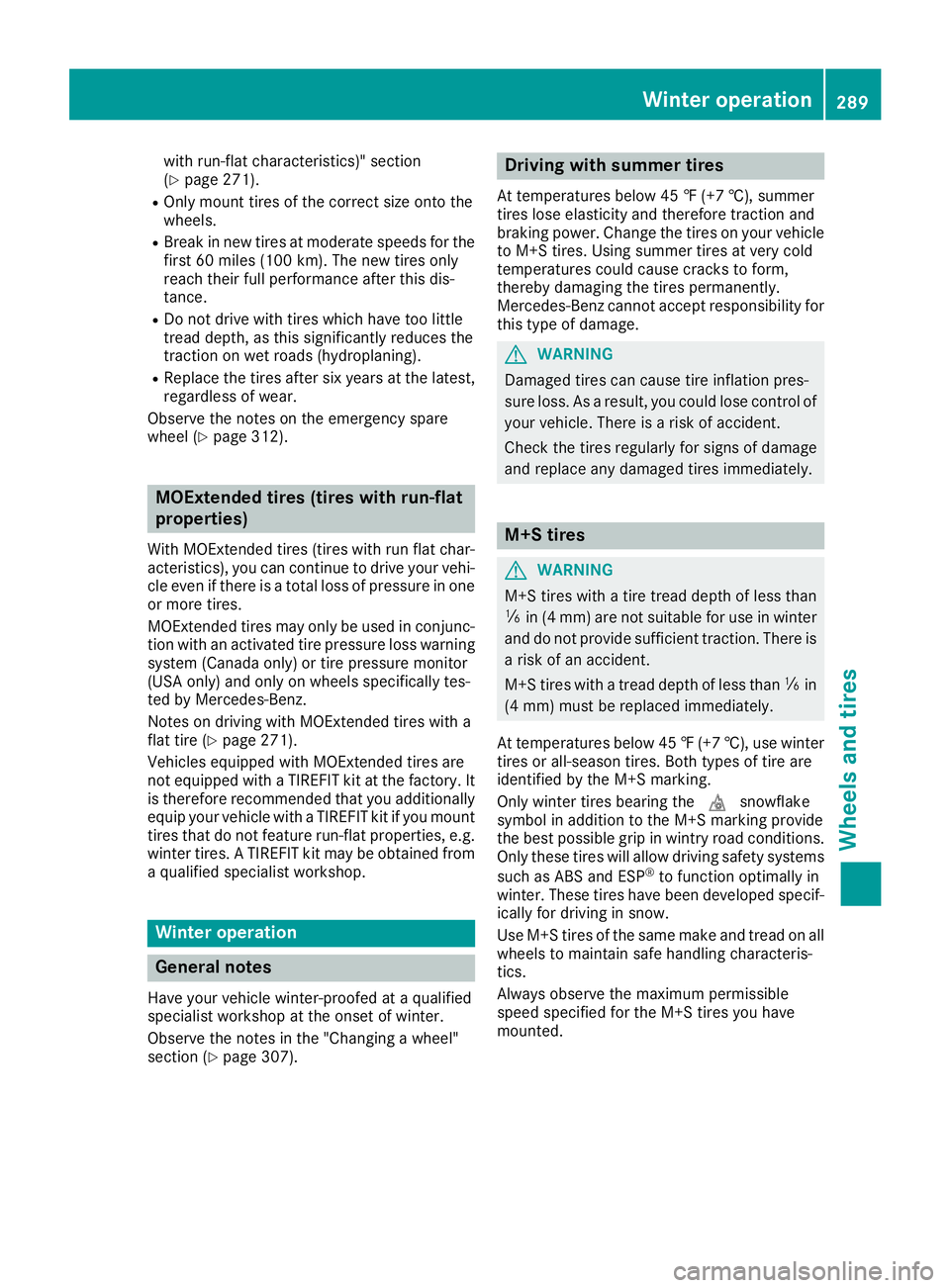
with run-flat characteristics) "s ection
( Y
page 271). R
Only moun tt ires of th ec orrec ts iz eo nt ot he
wheels. R
Break in new tires at moderat es peeds for the
firs t6 0m iles (10 0k m) .T he ne wt ires only
reac ht he ir full performanc ea fter this dis-
tance. R
Do not driv ew ith tires which have too little
tread depth, as this significantly reduces the
traction on wet roads (hydroplaning). R
Replace th et ires after six years at th el atest,
regardless of wear.
Observe th en otes on th ee mergency spare
wheel ( Y
page 312).
MOExtended tires (tires with run-flat
properties) With MOExtended tires (tires with run flat char-
acteristics) ,y ou can continue to driv ey our vehi-
cle even if there is at otal loss of pressure in one
or mor et ires.
MOExtended tires may only be used in conjunc-
tio nw ith an activated tir ep ressure loss warning
system (Canada only) or tir ep ressure monitor
(US Ao nly) and only on wheels specifically tes-
ted by Mercedes-Benz.
Notes on driving with MOExtended tires with a
flat tir e( Y
page 271).
Vehicles equipped with MOExtended tires are
not equipped with aT IREFIT kit at th ef actory. It
is therefore recommended that you additionally
equip your vehicle with aT IREFIT kit if you mount
tires that do not feature run-flat properties, e.g.
winter tires. AT IREFI Tk it may be obtained from
aq ualified specialist workshop.
Winter operation
General notes Have your vehicle winter-proofed at aq ualified
specialist workshop at th eo nset of winter.
Observe th en otes in th e" Changing aw heel"
sectio n( Y
page 307). Driving with summer tires At temperatures below 45 ‡( +7 †) ,s umme r
tire sl os ee las ti cit ya nd therefore traction and
braking power .C hange th et ires on your vehicle
to M+S tires. Usin gs ummer tires at ver yc old
temperatures coul dc aus ec ra ck stof orm,
thereb yd amaging th et ires permanently.
Mercedes-Ben zc anno ta ccept responsibilit yf or
this type of damage.
G WARNING
Damaged tires can caus et ir ei nflation pres-
sure loss .Asar esult, you coul dl ose control of
your vehicle .T her eisar isk of accident.
Chec kt he tires regularly for sign sofd amage
and replace any damage dt ires immediately.
M+S tires
G WARNING
M+S tires with at ir et re ad dept hofl ess than
�
Page 292 of 326
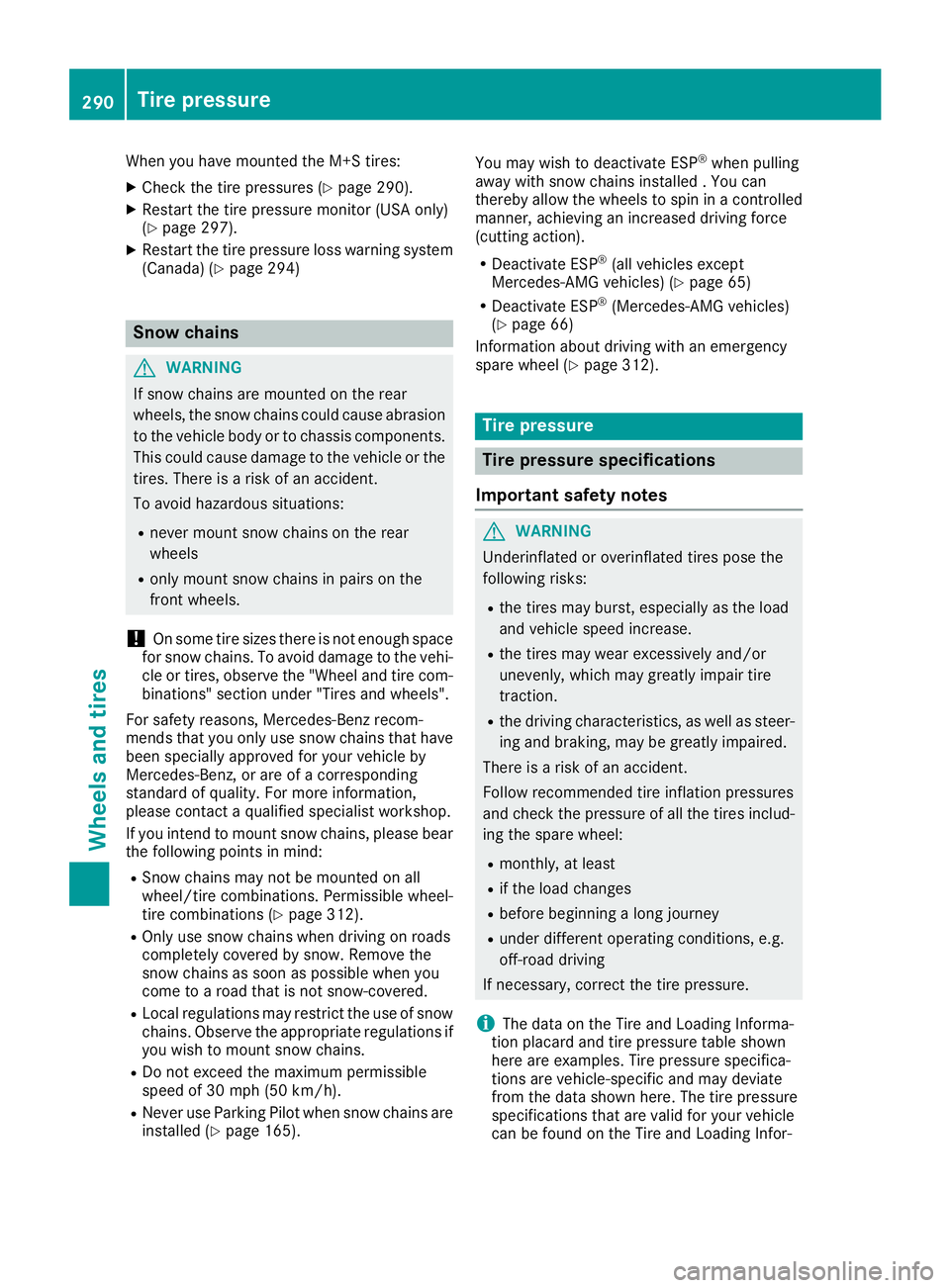
When you have mounted the M+S tires: X
Check the tire pressures ( Y
page 290).X
Restart the tire pressure monitor (USA only)
( Y
page 297).X
Restart the tire pressure loss warning system
(Canada) ( Y
page 294)
Snow chains
G WARNING
If snow chains are mounted on the rear
wheels, the snow chains could cause abrasion
to the vehicle body or to chassis components.
This could cause damage to the vehicle or the
tires. There is ar isk of an accident.
To avoid hazardous situations: R
never mount snow chains on the rear
wheels R
only mount snow chains in pairs on the
fron tw heels.
! On some tire sizes there is not enough space
for snow chains. To avoid damage to the vehi-
cle or tires, observe the "Wheel and tire com-
binations" section under "Tires and wheels".
For safety reasons, Mercedes-Benz recom-
mends that you only use snow chains that have
been specially approved for your vehicle by
Mercedes-Benz ,ora re of ac orresponding
standard of quality. For more information,
please contact aq ualified specialist workshop.
If you inten dtom ount snow chains, please bear
the following points in mind: R
Sno wc hains may not be mounted on all
wheel/tire combinations. Permissible wheel-
tire combinations ( Y
page 312).R
Only use snow chains when driving on roads
completely covered by snow. Remove the
snow chains as soon as possible when you
come to ar oad that is not snow-covered.R
Local regulations may restrict the use of snow
chains. Observe the appropriate regulations if
you wish to mount snow chains. R
Do not exceed the maximum permissible
speed of 30 mph (50 km/h). R
Never use Parking Pilot when snow chains are
installed ( Y
page 165). You may wish to deactivat eE SP ®
when pulling
away with snow chains installed .Y ou can
thereby allow the wheels to spin in ac ontrolled
manner, achieving an increased driving force
(cutting action). R
Deactivate ESP ®
(all vehicles except
Mercedes-AMG vehicles) ( Y
page 65)R
Deactivate ESP ®
(Mercedes-AMG vehicles)
( Y
page 66)
Information about driving with an emergency
spare wheel ( Y
page 312).
Tir ep re ssure
Tir ep re ssure specifications
Important safety notes
G WARNING
Underinflated or overinflated tires pose the
following risks: R
the tires may burst, especially as the load
and vehicle speed increase. R
the tires may wear excessively and/or
unevenly, which may greatly impair tire
traction. R
the driving characteristics, as well as steer-
ing and braking, may be greatly impaired.
There is ar isk of an accident.
Follow recommended tire inflation pressures
and check the pressure of all the tires includ-
ing the spare wheel: R
monthly, at least R
if the load changes R
before beginnin gal ong journeyR
under differen to perating conditions, e.g.
off-road driving
If necessary, correct the tire pressure.
i The data on the Tire and Loading Informa-
tion placard and tire pressure table shown
here are examples. Tire pressure specifica-
tions are vehicle-specific and may deviate
from the data shown here. The tire pressure
specifications that are valid for your vehicle
can be found on the Tire and Loading Infor-290
Tir ep re ssure
Wheels and tires